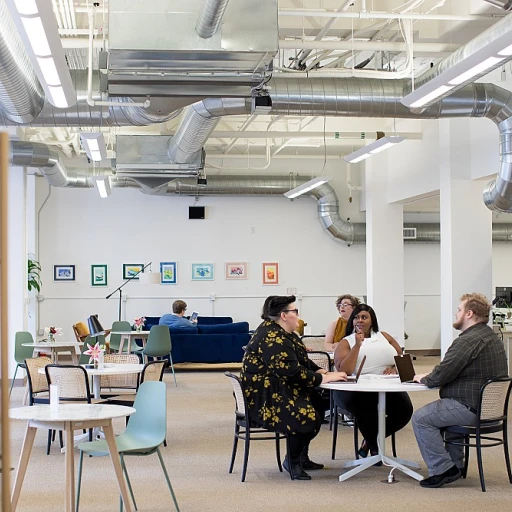Understanding the Role of Leaders of Leaders
Grasping the Responsibility of Leading Leaders
In the intricate landscape of change management, the impact of leaders who guide other leaders is profound. These individuals are tasked with steering senior leaders, mid-level managers, and team members through the complex waters of transformation. Their primary role is to ensure that the programs and strategies set in place are executed effectively, creating a ripple effect throughout the organization.
Leaders of leaders are not just focused on their direct reports; their influence extends far beyond, affecting the entire business ecosystem. When leadership development programs are thoughtfully crafted and implemented, they empower leaders to enhance their leadership style and decision-making capabilities.
To excel in this influential role, leaders must hone specific skills and adopt effective strategies. They need to master the art of supporting and coaching leaders, enabling them to lead teams that adapt successfully to new challenges. This often means fostering a robust company culture that encourages ongoing learning and development.
Understanding the role of these leaders also involves recognizing the potential barriers they face in driving change. Resistance within teams and from other team members can be a significant challenge, and it's crucial to employ strategies that target both the emotional and rational aspects of change.
A successful leader of leaders will lean into these challenges with confidence, using their learning experiences and insights to guide others. The ultimate goal is to create a resilient and adaptive organization that thrives long-term. For more on understanding these key roles, consider checking out the
role of a change agent in facilitating successful transformations.
Key Skills for Effective Leadership in Change
Essential Leadership Skills for Change Management
In the realm of change management, effective leadership hinges on several critical skills that are pivotal for leaders overseeing transformative processes. These skills lay the foundation for leading teams through transitions and ensuring successful outcomes.
- Decision Making: An effective leader in change management is characterized by sound decision-making abilities. They must evaluate various options quickly and choose paths that align with the strategic goals of the business. Leaders with reliable decision-making skills guide teams confidently, building trust among team members.
- Communication Skills: Clear and open communication is the backbone of any successful change initiative. Leaders must articulate their vision and convey the need for change in a compelling way. This ensures all employees understand the direction of the organization, fostering a sense of shared purpose.
- Adaptability and Learning: Change is unpredictable, requiring leaders to adapt swiftly to evolving circumstances. Emphasizing continuous learning and acquiring new skills enables leaders to navigate unforeseen challenges effectively. This commitment to learning is not only a personal journey but also influences the wider organizational culture.
- Influence and Coaching: Leaders inspire others through influence rather than authority. Great leaders harness their influence to coach team members, offering guidance and support throughout the change process. By empowering others, they cultivate new leaders within the organization and encourage a collaborative spirit.
- Resilience in the Face of Challenges: Change initiatives often encounter resistance. An effective leader maintains resilience and encourages the team to persevere, even when progress seems slow. By demonstrating resilience, leaders foster a culture of endurance that resonates through the organization.
For more insights on the inherent challenges leaders face in this role, explore the concept of
navigating challenges when filling vacant roles. This understanding is critical for developing comprehensive leadership programs designed to equip leaders with these essential skills.
Cultivating these skills not only increases the effectiveness of leadership but also leaves a lasting impact on the organization, propelling it towards long-term success.
Building a Culture of Adaptability
Fostering a Proactive Workforce
Cultivating a culture of adaptability within an organization begins with the leaders of leaders, who must embrace the role of fostering a proactive and dynamic workforce. These individuals are not just change participants; they are the architects steering the company through evolutionary phases. By working closely with teams and identifying areas for growth, leaders can enhance the collective adaptability of the business.
A culture that welcomes change requires effective leaders to prioritize continuous learning experiences for themselves and their team members. Programs focused on leadership development are pivotal to this process, where leaders will undergo comprehensive coaching sessions that expand their leadership skills and aid in decision making.
Engagement and Transparency: Cornerstones of Change
To achieve a culture of adaptability, organizations must focus on engaging employees and maintaining transparency in communication. An effective leader facilitates open dialogue, providing clarity on the objectives and benefits of change initiatives. This approach minimizes uncertainty and empowers teams to embrace transformations rather than resist them.
It’s essential to address employee concerns promptly and ensure they are kept informed throughout the change process. This can significantly impact the program's success by fostering an environment where people feel valued and are more willing to collaborate. A great leader supports their teams by being approachable, honest, and receptive to feedback.
Building Resilience for Long-term Success
Developing a culture where adaptability is ingrained in the DNA of the organization entails nurturing resilience among employees. Senior leaders have the responsibility of embedding this strength by aligning team goals with the business's vision. Leadership training and development programs focus on enhancing not only the practical skills but also the psychological resilience necessary for enduring periods of transition.
Over time, this creates a workplace that is not only prepared for change but thrives on it. Ensuring leaders are equipped with the tools to adapt and lead through change lays the groundwork for sustained success. Investing in leadership skills now pays dividends in long-term organizational health and operational excellence.
For further insight on enhancing adaptability within your company culture, consider exploring strategies for
enhancing employee assessment in change management. This will provide additional context and actionable steps to strengthen adaptability across all levels of the organization.
Overcoming Resistance to Change
Embracing Change: A Path to Minimizing Resistance
Resistance to change is a natural human response. However, it can be tackled effectively when leaders of leaders equip themselves and their teams with the right strategies. Understanding an organization's dynamics and the reasons behind resistance is crucial. Through targeted leadership training, mid-level and senior leaders can learn to navigate and mitigate these challenges before they escalate.
One of the most impactful ways to address resistance is through effective communication. Open dialogue allows team members to express their concerns and ideas, fostering a transparent environment. This dialogic approach helps build trust and ensures that employees feel heard and valued, reducing resistance over time. Implementing a robust feedback loop can enhance this process, providing employees with a sense of involvement in the decision-making process.
Additionally, promoting a culture of adaptability within the organization can further assist in overcoming resistance. Leaders will discover that when they focus on cultivating a mindset open to learning and growth, they empower their teams to embrace change rather than fear it. This is not only a testament to their leadership skills but also a reflection of the organization’s commitment to development programs that aid in the seamless transition through periods of change.
Another essential tool to diminish resistance is the development of effective coaching programs. These initiatives allow senior and mid-level leaders to mentor their teams, providing personalized guidance and support throughout the change process. Coaching leaders on how to employ empathetic listening and offer constructive feedback can have a significant impact on how change is perceived and accepted.
Lastly, aligning change initiatives with the company culture and values helps in making the transition smooth and appealing to all employees. Business leaders should recognize the influence of tailored approaches that align with organizational goals and values, ensuring that employees understand the "why" behind the change.
By implementing these strategies, leaders can reduce resistance, driving change initiatives to success, and fostering an environment that supports continuous learning and development.
Measuring Success in Change Initiatives
Tracking the Impact and Gauging the Success of Change Initiatives
Effectively measuring the success of change initiatives remains an essential task for leaders of leaders. The role of leadership in facilitating change isn't just about implementing new strategies or policies; it's also about ensuring those strategies yield the expected results. To ascertain success, senior leaders need to deploy comprehensive mechanisms that evaluate various facets of change.
- Establish Clear Objectives: From the onset, a shift in strategy should align with the overarching goals of the organization. By identifying measurable targets, leaders can determine progress.
- Embrace Quantitative and Qualitative Metrics: While quantifiable results are critical for assessing progress, qualitative feedback from employees provides insights into the effectiveness of leadership style and company culture changes.
- Regular Check-ins with Teams: Effective leaders will maintain open communication channels within their teams. Understanding team members' experiences during change offers real-time data on how well the teams adapt.
- Utilize Data Analytics: Leveraging data analytics tools not only helps track progress but also identifies areas needing improvement. Over time, patterns can emerge, offering insights into the long term impact of the change.
- Feedback Loops: Continual learning experiences derived from feedback loops allow mid-level leadership and team members to refine their processes.
Developing a robust program for change measurement equips leaders with valuable insights into organizational dynamics and fosters a culture of adaptability. As part of a comprehensive leadership development program, integrating measurement tactics with decision making and leadership skills will support both short-term achievements and long-term success, ensuring that leaders and their teams can effectively navigate future transformations.
Continuous Development for Leaders of Leaders
Fostering Ongoing Growth for Leaders at the Helm
The journey of leadership doesn’t conclude with successful change initiatives. For leaders responsible for other leaders, continuous development is the key to sustained success and adaptability in turbulence. To effectively guide their teams, leaders must remain committed to learning experiences that refine their leadership skills and styles.
Ongoing development not only enhances leadership skills but also fosters a culture where team members feel empowered and motivated to contribute to the organization's growth. Here are several strategies to ensure leaders continue to evolve in their roles:
- Leadership Development Programs: Organizations should invest in comprehensive development programs tailored to the needs of mid-level and senior leaders. These programs can include workshops, seminars, and online courses that focus on enhancing decision-making and strategic thinking skills.
- Mentoring and Coaching: One of the most effective ways to develop leadership capabilities is through mentoring and coaching leaders. This approach allows for personalized feedback and guidance, enabling leaders to navigate complex business challenges with greater confidence and ease.
- Regular Learning Experiences: Encourage leaders to participate in ongoing learning experiences that promote adaptability and innovation. This could involve cross-functional team projects or exposure to new business areas to broaden their perspectives.
- Feedback Mechanisms: Constructive feedback is crucial for personal development. Implement feedback loops where leaders can receive input from their peers, employees, and supervisory figures to identify areas for improvement.
The commitment to continuous development not only impacts individual leaders but also shapes the overall company culture, encouraging a mindset geared towards long-term growth and adaptability. Great leaders understand that even after achieving success in change initiatives, the work doesn’t stop, and the pursuit of excellence is ongoing, ensuring they stay ahead in ever-evolving business landscapes.














